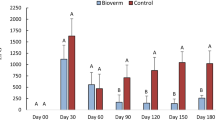Abstract
Communally grazed sheep were dosed at 4-, 12-, 24- or 48-week intervals for 1 year. Dosing every 4 weeks proved to be the most effective (p<0.05), as reflected in a lower worm egg count compared to the 12-, 24- or 48-week intervals. Since most nematode life cycles lie between 3 and 6 weeks, the treatment has to be given during this critical period if maximum economic advantage is to be gained from deworming. However, treating communally grazed sheep every 12 weeks was found to keep worm egg numbers relatively low and may be advantageous in providing seasonal control, especially in semi-arid environments. Dosing communally grazed sheep once or twice a year under the same conditions is not recommended because reinfection appeared to result in similar faecal egg counts to those from the untreated animals (p>0.05).
Similar content being viewed by others
REFERENCES
Allonby, E.W. and Urquhart, G.M., 1975. The epidemiology and pathogenic significance of haemonchosis in a Merino £ock in East Africa. Veterinary Parasitology, 1, 129-143
Bakunzi, F.R. and Serumaga-Zake, P.A.E., 1996. Faecal nematode load in communally grazed sheep before and after dosing at six and twelve week intervals. Uniswa Journal of Agriculture, 5, 127-129
Brundson, R.V., 1980. Principles of helminth control. Veterinary Parasitology, 6, 185-215
Connan, R.M., 1973. The influence of anthelmintic treatment of ewes on the relative proportions of gastrointestinal nematode parasites in their lambs. The Veterinary Record, 92, 513-514
Devendra, C., 1981. Potential of sheep and goats in less developed countries. Journal of Animal Science, 51, 461-473
Gatongi, P.M., Scott, M.E., Ranjan, S., Gathuma, J.M., Munyua, W.K., Chrruiyot, H. and Prichard, R.K., 1997. Effects of three nematode anthelmintic treatment regimes on £ock performance of sheep and goats under extensive management in semi-arid Kenya. Veterinary Parasitology, 68, 323-336
Louw, J.P., 1989. Overberg Research Projects; III. A preventive worm control program for sheep in the Ruens, in the winter rainfall region of South Africa. Journal of the South AfricanVeterinary Association, 60, 186-190
Louw, J.P. and Reinecke, R.K., 1991. Overberg Research Projects; XV. The efficacy of different anthelmintics against field strains of nematode parasites of sheep in the Southern Cape province. Journal of the South African Veterinary Association, 62, 101-103
Meyers, G.H., 1991. Parasite control important in grazing beef cattle. Feedstuffs, 63, 14
Morley, F.H.W. and Donald, A.D., 1980. Farm management and systems of helminth control. Veterinary Parasitology, 6, 23
Muirhead, S., 1991. Strategic swine management program interrupts parasite infection cycle. Feedstuffs, 63, 23
Oosthuizen, W.T.J. and Erasmus, J.B., 1993. Efficacy of moxidectin against a strain of Haemonchus contortus resistant to ivermectin, a benzimidazole and a salicylanide. Journal of the South African Veterinary Association, 64, 9-12
Prichard, R.K., 1988. Anthelmintics and control. Veterinary Parasitology, 27, 97-109
Reinecke, R.K., 1983. Veterinary Helminthology, (Butterworth Publishers, Durban/Pretoria), 321-331
Reinecke, R.J. and Louw, J.P., 1989. Overberg Research Projects. The epidemiology of parasite nematodes in ewes, suckling lambs and weaners. Journal of the South African Veterinary Association, 60, 176-185
SAS, 1990. SAS User's Guide Statistics, 5th edn, (SAS Institute, Cary, NC), 2, 891-996
Stromberg, B.E. and Corwin, R.M., 1993. Epizootiology of Ostertagia ostertagi in cow-calf production systems in the American Midwest. Veterinary Parasitology, 46, 297-302
Stromberg, B.E., Schlotthauer, J.S., Haggard, D.L., Vatthauer, R.J., Hanke, H.E. and Myers, G.H., 1991. Epizootiology of helminth parasitism in a beef/calf herd in Minnesota. American Journal of Veterinary Research, 52, 1712-1716
VanWyk, J.A., 1990. Review of chemical methods available for the control of gastro-intestinal nematodes of sheep and cattle. Journal of the South African Veterinary Association, 61, 136-140
Waller, P.J., 1993. Control strategies to prevent resistance. Veterinary Parasitology, 46, 133-142
Author information
Authors and Affiliations
Rights and permissions
About this article
Cite this article
Bakunzi, F., Serumaga-Zake, P. The Effect of Strategic Anthelmintic Treatment on Internal Parasites in Communally Grazed Sheep in a Semi-Arid Area as Reflected in the Faecal Nematode Egg Count. Tropical Animal Health and Production 32, 295–302 (2000). https://doi.org/10.1023/A:1005264906954
Issue Date:
DOI: https://doi.org/10.1023/A:1005264906954




